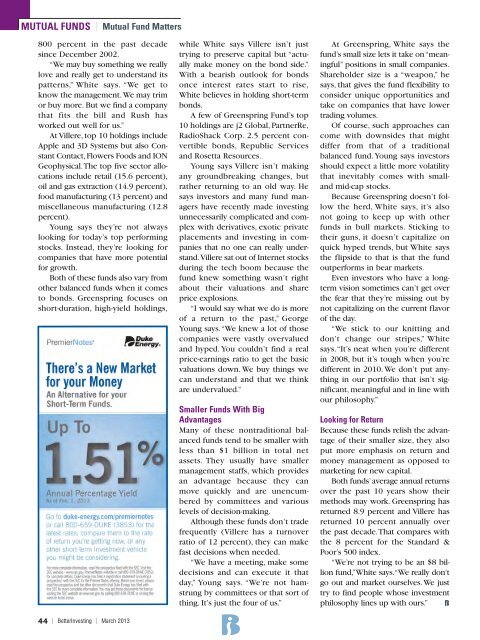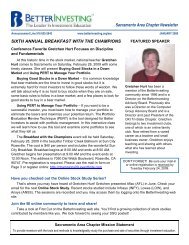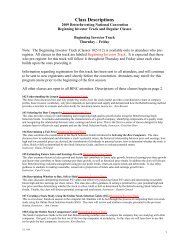STOCK TO STUDY: T. Rowe Price Group, Inc ... - BetterInvesting
STOCK TO STUDY: T. Rowe Price Group, Inc ... - BetterInvesting
STOCK TO STUDY: T. Rowe Price Group, Inc ... - BetterInvesting
You also want an ePaper? Increase the reach of your titles
YUMPU automatically turns print PDFs into web optimized ePapers that Google loves.
MUTUAL FUNDS | Mutual Fund Matters<br />
800 per cent in the past decade<br />
since December 2002.<br />
“We may buy something we really<br />
love and really get to understand its<br />
patterns,” White says. “We get to<br />
know the management.We may trim<br />
or buy more. But we find a company<br />
that fits the bill and Rush has<br />
worked out well for us.”<br />
At Villere, top 10 holdings include<br />
Apple and 3D Systems but also Con -<br />
stant Contact, Flowers Foods and ION<br />
Geophysical. The top five sector allocations<br />
include retail (15.6 percent),<br />
oil and gas extraction (14.9 percent),<br />
food manufacturing (13 percent) and<br />
miscellaneous manufacturing (12.8<br />
percent).<br />
Young says they’re not always<br />
looking for today’s top performing<br />
stocks. Instead, they’re looking for<br />
com panies that have more potential<br />
for growth.<br />
Both of these funds also vary from<br />
other balanced funds when it comes<br />
to bonds. Greenspring focuses on<br />
short-duration, high-yield holdings,<br />
while White says Villere isn’t just<br />
trying to preserve capital but “actu -<br />
ally make money on the bond side.”<br />
With a bearish outlook for bonds<br />
once interest rates start to rise,<br />
White believes in holding short-term<br />
bonds.<br />
A few of Greenspring Fund’s top<br />
10 holdings are j2 Global, PartnerRe,<br />
RadioShack Corp. 2.5 percent convertible<br />
bonds, Republic Services<br />
and Rosetta Re sources.<br />
Young says Villere isn’t making<br />
any groundbreaking changes, but<br />
rather returning to an old way. He<br />
says investors and many fund managers<br />
have recently made investing<br />
unnecessarily complicated and complex<br />
with derivatives, exotic private<br />
placements and investing in com -<br />
panies that no one can really understand.Villere<br />
sat out of Internet stocks<br />
during the tech boom because the<br />
fund knew something wasn’t right<br />
about their valuations and share<br />
price explosions.<br />
“I would say what we do is more<br />
of a return to the past,” George<br />
Young says. “We knew a lot of those<br />
companies were vastly overvalued<br />
and hyped. You couldn’t find a real<br />
price-earnings ratio to get the basic<br />
valuations down. We buy things we<br />
can understand and that we think<br />
are undervalued.”<br />
Smaller Funds With Big<br />
Advantages<br />
Many of these nontraditional balanced<br />
funds tend to be smaller with<br />
less than $1 billion in total net<br />
assets. They usually have smaller<br />
management staffs, which provides<br />
an advantage because they can<br />
move quickly and are unencumbered<br />
by committees and various<br />
levels of decision-making.<br />
Although these funds don’t trade<br />
frequently (Villere has a turnover<br />
ratio of 12 percent), they can make<br />
fast decisions when needed.<br />
“We have a meeting, make some<br />
decisions and can execute it that<br />
day,” Young says. “We’re not hamstrung<br />
by committees or that sort of<br />
thing. It’s just the four of us.”<br />
At Greenspring, White says the<br />
fund’s small size lets it take on “meaningful”<br />
positions in small companies.<br />
Shareholder size is a “weapon,” he<br />
says, that gives the fund flexibility to<br />
consider unique opportunities and<br />
take on companies that have lower<br />
trading volumes.<br />
Of course, such approaches can<br />
come with downsides that might<br />
differ from that of a traditional<br />
balanced fund. Young says investors<br />
should expect a little more volatility<br />
that inevitably comes with smalland<br />
mid-cap stocks.<br />
Because Greenspring doesn’t follow<br />
the herd, White says, it’s also<br />
not going to keep up with other<br />
funds in bull markets. Sticking to<br />
their guns, it doesn’t capitalize on<br />
quick hyped trends, but White says<br />
the flipside to that is that the fund<br />
outperforms in bear markets.<br />
Even investors who have a longterm<br />
vision sometimes can’t get over<br />
the fear that they’re missing out by<br />
not capitalizing on the current flavor<br />
of the day.<br />
“We stick to our knitting and<br />
don’t change our stripes,” White<br />
says. “It’s neat when you’re different<br />
in 2008, but it’s tough when you’re<br />
different in 2010. We don’t put anything<br />
in our portfolio that isn’t significant,<br />
meaningful and in line with<br />
our philo sophy.”<br />
Looking for Return<br />
Because these funds relish the advantage<br />
of their smaller size, they also<br />
put more emphasis on return and<br />
money management as opposed to<br />
marketing for new capital.<br />
Both funds’ average annual re turns<br />
over the past 10 years show their<br />
methods may work. Green spring has<br />
returned 8.9 percent and Villere has<br />
returned 10 percent annually over<br />
the past decade. That compares with<br />
the 8 percent for the Standard &<br />
Poor’s 500 index.<br />
“We’re not trying to be an $8 billion<br />
fund,” White says. “We really don't<br />
go out and market ourselves. We just<br />
try to find people whose investment<br />
philosophy lines up with ours.”<br />
44 | <strong>BetterInvesting</strong> | March 2013





